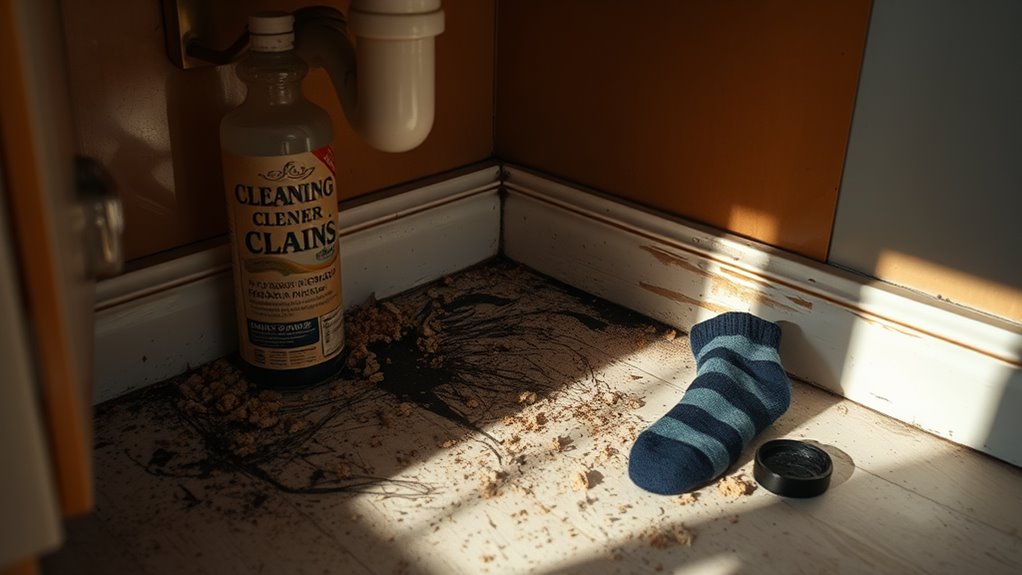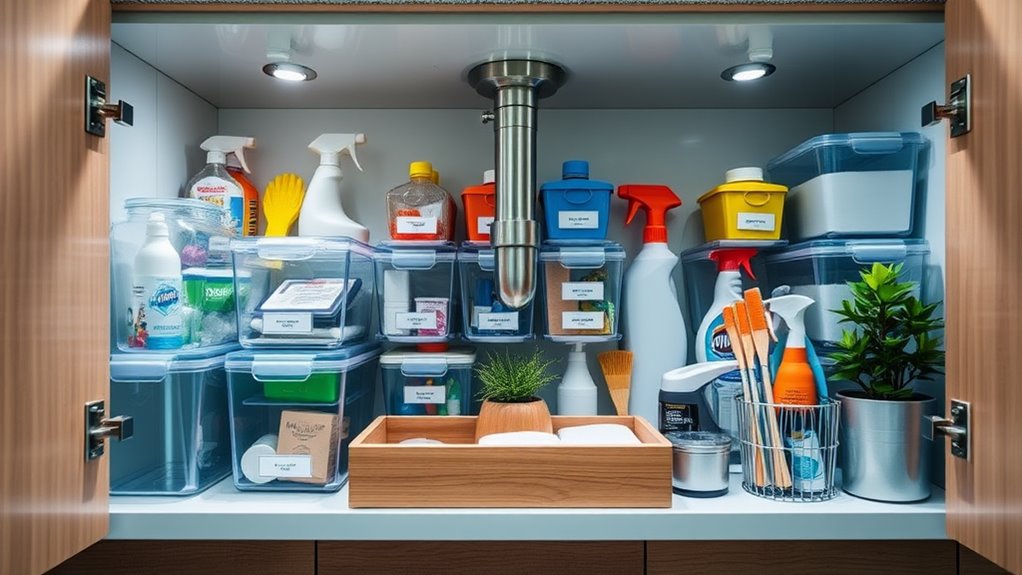The Most Overlooked Spot in Your Kitchen That Needs Cleaning NOW
One of the most overlooked spots in your kitchen that needs cleaning now is your refrigerator seals. They can trap moisture and food particles, creating a breeding ground for harmful bacteria. If you don’t check and clean them regularly, you risk compromising food safety. Plus, don’t forget other hidden areas like under the sink and behind appliances. If you want to discover more hidden hazards in your kitchen, keep exploring the details that often get neglected.
Key Takeaways
- The area under the sink is a hidden germ hotspot; regular cleaning and organization are essential for safety and hygiene.
- Refrigerator seals trap moisture and food particles, necessitating regular inspection and cleaning to prevent bacterial growth.
- Dust and grime accumulate on cabinet tops, making them allergen hotspots that require frequent cleaning to maintain a pristine kitchen.
- The interior of the microwave often harbors hidden germs; regular cleaning is crucial to prevent bacteria buildup and unpleasant odors.
- Cutting boards can harbor harmful bacteria; clean them immediately after use and sanitize regularly to ensure food safety.
The Hidden Hazards of Refrigerator Seals
While you mightn’t give much thought to your refrigerator seals, they can harbor hidden hazards that affect your food’s safety. These kitchen details often trap moisture and food particles, creating a breeding ground for bacteria. To guarantee your food stays fresh, inspect those seals regularly. A simple wipe down with a mild cleaner can eliminate grime and prevent unwanted odors. Additionally, using natural cleaning solutions can help ensure that harmful chemicals don’t contaminate your food. Regularly deep cleaning your refrigerator, including the seals, can significantly enhance food safety standards and prolong the appliance’s lifespan. Don’t forget to check for cracks or tears, which can compromise their effectiveness. When these seals fail, cold air escapes, making your refrigerator work harder, leading to energy waste. Proper maintenance of these seals, including effective cleaning techniques, is essential for optimal performance. Remember, small kitchen appliances also rely on clean seals to operate efficiently and prolong their lifespan. Furthermore, organizing your fridge with clear storage bins can improve visibility and accessibility, making it easier to spot any issues with the seals.
Unseen Germs in Under-Sink Areas
You mightn’t think much about the area under your sink, but it can harbor hidden germ hotspots. Storing cleaning supplies there can pose risks if spills or leaks occur, creating perfect breeding grounds for bacteria. Regular maintenance is essential to keep this space clean and safe for your kitchen. Additionally, removing mineral deposits from faucet surfaces can help prevent the spread of germs and maintain overall cleanliness. Using natural ingredients like vinegar can effectively sanitize these surfaces without introducing harmful chemicals. To enhance your cleaning routine, consider implementing smart organization tips that not only optimize storage but also streamline access to your cleaning supplies. Incorporating preventive measures such as using cabinet liners can help protect surfaces from moisture and stains. Furthermore, utilizing an eco-friendly all-purpose cleaner can provide a safe and effective way to maintain the cleanliness of your kitchen appliances.
Hidden Germ Hotspots
Beneath your kitchen sink lies a hidden germ hotspot that often goes unnoticed. This area, frequently damp and dark, provides a perfect breeding ground for bacteria and mold.
You mightn’t think about it, but the surfaces and items stored here can harbor unseen germs that contaminate your kitchen. The plumbing leaks, drips, and spills contribute to the accumulation of grime, making regular cleaning vital.
To master your kitchen hygiene, inspect this space regularly. Remove items, clean the shelves with a disinfectant, and guarantee proper airflow to minimize moisture.
Pay close attention to corners and crevices where dirt settles. By tackling this overlooked area, you’ll create a cleaner, healthier kitchen environment that supports your culinary endeavors.
Cleaning Supplies Storage Risks
Many people overlook the risks associated with storing cleaning supplies under the sink, where unseen germs can thrive.
This cramped, dark environment is a breeding ground for bacteria and mold, especially if spills occur or containers leak. You might think your cleaning agents are safe, but improper storage can lead to contamination and cross-contamination, particularly if you store food items nearby.
Additionally, moisture and lack of ventilation exacerbate these risks, creating a perfect storm for harmful microbes.
To master your kitchen hygiene, regularly inspect and organize this area, ensuring it remains clean and dry. By addressing these unseen dangers, you can elevate your cleaning routine and create a healthier kitchen environment.
Don’t let neglect compromise your efforts!
Regular Maintenance Importance
Regular maintenance of under-sink areas can greatly reduce the risk of unseen germs taking hold. This often-neglected space is a breeding ground for moisture and spills, creating the perfect environment for bacteria and mold.
By routinely checking for leaks and cleaning surfaces, you can prevent the accumulation of these harmful microorganisms. Use a disinfectant cleaner to wipe down shelves and containers, ensuring you reach into the corners where grime hides.
Also, evaluate your cleaning supplies regularly; expired products can contribute to unpleasant odors and potential hazards. Incorporating this simple maintenance routine not only protects your health but also enhances the overall cleanliness of your kitchen.
Dust and Grime on Cabinet Tops
While you might focus on the surfaces you use daily, dust and grime often accumulate on the tops of your kitchen cabinets, creating an unsightly layer that can easily be forgotten. This neglected area can harbor allergens and diminish your kitchen’s overall aesthetic. In fact, refrigerator seals and other essential cleaning spots like these can significantly impact the overall cleanliness of your home. You’ll want to incorporate regular cleaning of these high surfaces to maintain a pristine environment. Consider these essential steps for effective cleaning:
- Use a microfiber cloth to trap dust effectively.
- Dampen the cloth with a gentle cleaner for stubborn grime.
- Wipe in a back-and-forth motion to cover all areas.
- Follow up with a dry cloth to prevent streaks.
- Regularly check and clean this space to keep it fresh. Additionally, eco-friendly alternatives to harsh chemicals can make your kitchen safer for your family while ensuring effective cleaning. Using natural kitchen sanitizing methods can further enhance your cleaning routine.
Additionally, proper cleaning techniques are crucial for ensuring that these areas remain free from buildup. Mastering this task is key to a truly clean kitchen.
The Forgotten Microwave Interior
You mightn’t think about it, but the interior of your microwave can hide a lot of germs and bacteria.
Food splatters accumulate over time, making it essential to clean this often-overlooked appliance.
Fortunately, there are simple techniques that can help you tackle the mess and keep your microwave fresh.
Hidden Germs and Bacteria
Though it often gets overlooked during routine cleaning, the interior of your microwave can harbor a shocking amount of hidden germs and bacteria.
The warm, moist environment creates a perfect breeding ground for pathogens, which can compromise your food safety. Regularly disinfecting your microwave is essential to guarantee a healthy cooking space.
Consider these potential culprits lurking inside:
- Salmonella from undercooked poultry
- E. coli from improperly cleaned vegetables
- Listeria from expired leftovers
- Staphylococcus aureus from contaminated surfaces
- Yeast and mold from spilled food
Food Splatter Accumulation
As food splatters accumulate inside your microwave, they not only create an unsightly mess but also contribute to the growth of bacteria.
You mightn’t realize it, but those tiny bits of food can harbor harmful germs that thrive in a warm, moist environment. Each time you heat something, you risk splattering more particles, compounding the issue.
This buildup can affect the microwave’s efficiency, leading to uneven heating and unpleasant odors. Plus, neglecting this area jeopardizes your kitchen’s overall cleanliness.
Regularly checking and addressing the interior of your microwave is essential for maintaining a hygienic cooking space. Don’t let this overlooked spot become a breeding ground for bacteria; it deserves your attention now more than ever.
Simple Cleaning Techniques
Cleaning the inside of your microwave doesn’t have to be an intimidating task. With a few simple techniques, you can achieve a spotless interior in no time.
Start by gathering these items:
- 1 cup of water
- 1 tablespoon of white vinegar
- A microwave-safe bowl
- A clean, damp cloth
- Baking soda (for tough stains)
Begin by mixing water and vinegar in the bowl, then microwave it for 5 minutes. The steam will loosen grime, making it easier to wipe away.
Afterward, use the damp cloth to clean the walls and turntable. For stubborn stains, sprinkle baking soda, let it sit, and scrub gently.
With these techniques, you’ll master microwave maintenance effortlessly.
The Neglected Oven Door
While you may focus on scrubbing the interior of your oven, the door often gets overlooked. This surface bears the brunt of grease splatters and smudges, diminishing your kitchen’s overall cleanliness.
Start by evaluating the condition of your oven door; you might be surprised by the buildup. Use a mixture of baking soda and water to create a paste, applying it generously to stubborn stains. Let it sit for a while, then scrub gently with a non-abrasive sponge.
Don’t forget to wipe down the glass with a glass cleaner for that crystal-clear finish. Regularly cleaning your oven door not only enhances its appearance but also guarantees peak performance.
Master this task, and you’ll elevate your kitchen’s hygiene to new heights.
Bacteria Buildup on Cutting Boards
After addressing the grime on your oven door, it’s time to turn your attention to another often neglected kitchen item: cutting boards.
These surfaces can harbor harmful bacteria if not cleaned properly. You mightn’t realize how quickly they accumulate germs from food prep.
To maintain a pristine cutting board, consider the following practices:
- Use separate boards for raw meats and vegetables.
- Clean immediately after use with hot, soapy water.
- Sanitize with a vinegar solution or bleach mix.
- Store boards upright to allow air circulation.
- Periodically treat wooden boards with mineral oil to prevent cracking.
Cleaning Behind Large Appliances
Though it’s often out of sight, the area behind large appliances can be a breeding ground for dust, dirt, and even pests. Cleaning this space should be a regular part of your kitchen maintenance. Start by unplugging your appliances and moving them with care. Use a vacuum and a damp cloth to eliminate debris and grime. Here’s a simple guide to streamline your cleaning process:
| Task | Frequency |
|---|---|
| Dusting | Monthly |
| Deep Cleaning | Every 3-6 months |
| Pest Inspection | Quarterly |
The Overlooked Kitchen Drawer
The kitchen drawer often gets overlooked during cleaning sessions, yet it can accumulate crumbs, utensils, and forgotten items that create clutter.
To regain control over this space, it’s important to tackle it methodically. Start by emptying the drawer completely, and then inspect each item critically.
Consider removing:
- Old batteries
- Expired coupons
- Dull or broken utensils
- Random twist ties
- Unused gadgets
Once you’ve sorted through everything, wipe down the interior thoroughly to eliminate crumbs and dust.
Finally, only return items that add value to your cooking experience. By mastering this task, not only will you enhance your kitchen’s efficiency, but you’ll also cultivate a sense of order that inspires culinary creativity.
Maintaining Cleanliness in Pantry Corners
While you might focus on the visible shelves of your pantry, the corners often gather dust and forgotten food items that can lead to unpleasant odors and pests. To maintain cleanliness in these overlooked spots, start by emptying the corners completely.
Check for expired items or spills that might’ve gone unnoticed. Wipe down surfaces with a strong cleaner, targeting any sticky residue.
Next, consider using clear bins to organize small items, preventing clutter and making it easier to spot trouble areas. Regularly inspect your pantry for signs of pests; early detection saves you from larger infestations.
Finally, establish a cleaning routine—monthly checks will keep your pantry fresh and inviting, ensuring it’s a space you can truly master.
Frequently Asked Questions
How Often Should I Clean My Refrigerator Seals?
You should clean your refrigerator seals every month. Regular maintenance prevents buildup and guarantees a proper seal, enhancing energy efficiency. Use warm, soapy water and a soft cloth to keep them in top condition.
What Cleaning Products Are Safe for Under-Sink Areas?
For under-sink areas, you’ll want to use eco-friendly cleaners, vinegar, or baking soda. These options effectively tackle grime without harsh chemicals. Always guarantee good ventilation and wear gloves for extra protection while cleaning.
Can I Use Vinegar to Clean Microwave Interiors?
Yes, you can use vinegar to clean microwave interiors. Just mix equal parts water and vinegar in a bowl, microwave for a few minutes, and wipe down the interior with a cloth for a sparkling finish.
How Do I Safely Clean Behind My Refrigerator?
To safely clean behind your refrigerator, unplug it first. Then, gently pull it out, using a vacuum or cloth to remove dust and debris. Make sure to check the coils for maximum efficiency while you’re there.
What’S the Best Way to Sanitize Cutting Boards?
To sanitize cutting boards, scrub them with hot, soapy water. Rinse thoroughly, then apply a solution of one tablespoon of bleach per gallon of water. Let it sit for a few minutes before rinsing again.



